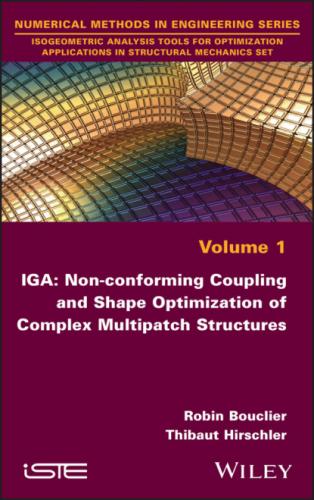The simple example of a plate with holes in Figure 1.16 underlines the difficulties of generating analysis-suitable models for IGA. From a more general point of view, there are mostly two ways to deal with this issue. First, we can strive to remove all trimmed regions by invoking re-parameterization strategies (as in Figure 1.16(c) and 1.16(d)), which can be cumbersome (Xu et al. 2013; Akhras et al. 2016; Massarwi et al. 2019). The second option consists of developing advanced numerical tools for analyzing models with the mentioned defects coming from the geometric modeling (Marussig and Hughes 2018; Teschemacher et al. 2018). The works presented in this book are heading in the second direction: in particular, trimming will be faced in Chapter 2 for the simulation of local phenomena within IGA models. Let us finally quote that the two approaches are not opposed, and, as already stated, it is by combining the innovations from both the geometrical and analysis sides that researchers and engineers will succeed in the long term.
Figure 1.16. Illustration of the trimming concept on a simple example of a plate with holes. For a color version of this figure, see www.iste.co.uk/bouclier/IGA.zip
1.4.2. Non-conforming multipatch parameterization
Unfortunately, trimming, as previously introduced, is not the only challenge in practice. A related question is the handling of complex non-conforming multipatch models. Indeed, a raw geometric model, as given by a CAD modeler, usually involves plenty of trimmed patches that arbitrarily intersect with each other. More specifically, again because of the rigid tensor product structure of (standard) multivariate spline basis, a single B-spline or NURBS patch cannot represent complex industrial structures. Instead, multiple (possibly trimmed) spline patches are required, where each of them describes a specific part of the overall structure. Multipatch modeling is thus inevitable when dealing with structures with non-trivial geometries using IGA. The main issue from an analytical point of view concerns the treatment of the junctions between those patches. Figure 1.17 illustrates the problem in relatively simple situations. The difficulty lies in the fact that geometric modeling does not pay special attention to the presence of multiple patches: each patch is defined independently. The parameterization of one patch is not defined under a particular constraint due to any other patches. It leads to patch interfaces with non-matching, or even non-conforming properties.
From here on, we use the following terminology to characterize those interfaces (same nomenclature as in Bouclier et al. (2017) and Guinard et al. (2018)); from the most restrictive to the most general case, we may encounter the coupling situation across:
1 – a matching interface, when it is aligned with some edges of the patches and the discretizations on both sides are exactly the same (same mesh refinements and same polynomial degrees);
2 – a conforming but non-matching interface, when it is aligned with some edges of the patches but the two discretizations (mesh refinements and/or polynomial degrees) differ;
3 – a non-conforming interface, when it can overlap some (knot-span) elements.
Spline-based CAD models seldom, if ever, have matching interfaces. Depending on the geometry, isogeometric modeling can lead to non-matching interfaces, as depicted in Figure 1.17 (left). But in the more general case, non-conforming interfaces between the patches are to be expected (see Figure 1.17, right).
Figure 1.17. B-spline and NURBS modeling generate multipatch geometries where each patch represents a specific part of the complete structure. Naturally, these patches undergo non-matching or even non-conforming parameterizations at their interfaces. Additional cumbersome procedures are required to get a final (standard) analysis-suitable model with conforming and matching interfaces. For a color version of this figure, see www.iste.co.uk/bouclier/IGA.zip
For the analysis of multipatch models, the same two complementary approaches used for trimming can be listed. The first one calls upon spline re-parameterization procedures to transform the patch junctions into fully matching interfaces (Maquart 2019), so that the only work, from the analysis point of view, is to concatenate the duplicated control points at the interfaces. Once again, this task is far from trivial, from a geometrical point of view, in practice. In the simplest case of a non-matching but conforming interface (see Figure 1.17, left), knot-insertion (or removal) and degree-elevation (or reduction) make it possible to comply to the requirements for obtaining a matching interface. An illustration of the process for the situation in Figure 1.17 (left) is given in Figure 1.18. However, transforming non-conforming interfaces into fully matching interfaces is much more delicate (see Figure 1.17 (right) and Figure 1.19, which shows the trace spaces along the interface for this example). It cannot be done by invoking the fundamental geometric algorithms (knot-insertion, degree-elevation, etc.), as done in the non-matching case. Instead, a complete re-parameterization has to be performed since the local changes introduced to reach a matching interface have a global influence on the whole discretization. As an illustration, despite its simple in-plane rectangular shape, Figure 1.17 (right) needs to be decomposed into six patches to get an overall parameterization with a matching interface. The problem stems from the fact that this re-parameterization can hardly be automated. In contrast, the second option is to develop advanced computational methods for coupling the non-conforming patches coming from the CAD. This path is followed in
